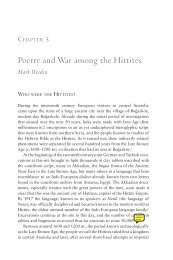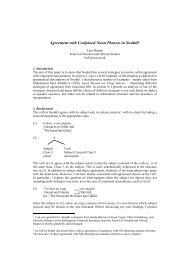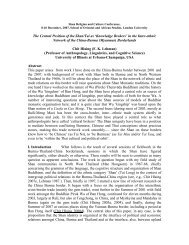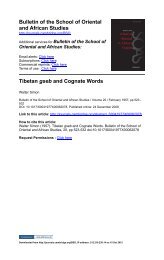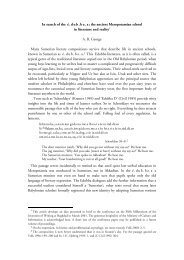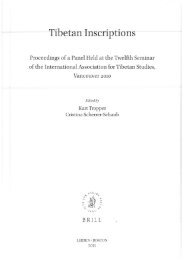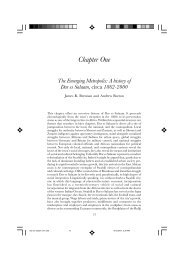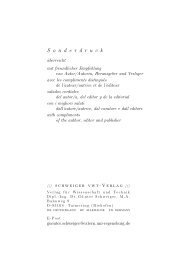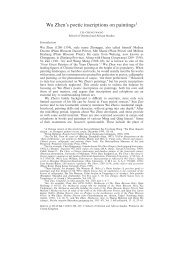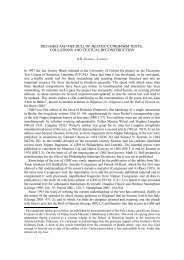000_JLC3_debut_FL - SOAS Research Online
000_JLC3_debut_FL - SOAS Research Online
000_JLC3_debut_FL - SOAS Research Online
Create successful ePaper yourself
Turn your PDF publications into a flip-book with our unique Google optimized e-Paper software.
18 G. Tucker Childs<br />
(2) Features defining the Macro-Sudan belt (Güldemann 2008)<br />
1. Logophoricity<br />
2. Labial velars<br />
3. ATR vowel harmony<br />
4. S-Aux-O-V-X<br />
5. Word order V-O-Neg<br />
6. Labial flap consonants<br />
Atlantic, he notes, is one of a number of “lineages” that “display an ambiguous behavior<br />
regarding linguistic commonalities with this area” (Güldemann 2008:152). With the<br />
exception of features 3 (height harmony is found in Atlantic) and 6, however, all features are<br />
found in the area under consideration. Another paper in this volume speaks of a “Sudanic<br />
linguistic area” (Clements and Rialland 2008: 81), although the authors find North Atlantic<br />
languages to be exceptional (p. 82). It is not clear why the South Atlantic languages and<br />
Bijogo are not also seen as exceptional, for they are indeed so in many of the same ways. 4 The<br />
general point of this brief consideration of recent work on language contact in the Mande-<br />
Atlantic area is that the area is not well understood and Atlantic in particular is said to be<br />
slightly anomalous. Further research, however, may prove this assessment to be inaccurate.<br />
The question is, of course, whether Mande and Atlantic were in contact long enough for<br />
there to be enough transfer of features either one way or the other to make the families similar<br />
enough to each other to constitute a linguistic area? One problem is that “groups” of<br />
languages are not frequently in contact with each other. The interaction is usually on a 1:1<br />
basis at geographical or sociological boundaries. A related problem is that the members of<br />
each group are not culturally homogeneous. Within Atlantic, for example, Temne, Wolof, and<br />
Fulfulde survived as widely spoken languages primarily because they were united at levels<br />
higher than the hamlet, the usual unit of organization for Atlantic groups. Within Mande, the<br />
speakers of the Mandeng languages, probably the result of the splintering of a group<br />
functioning centrally in the Mali Empire, were much more militaristic than, say, speakers of<br />
Eastern Mande languages. Other factors such as those suggested by the list in (1) are relevant:<br />
urbanization, employment patterns, technology, etc., all play a role in influencing contact<br />
outcomes.<br />
The next section examines the interaction between these two Niger-Congo language<br />
groups, i.e. Atlantic and Mande. The study of their contact is informative for many reasons,<br />
not least because they are typologically quite different. Both groups are concentrated in the<br />
western part of West Africa and have been in contact for centuries. Their interaction ranges<br />
socially from partial to complete assimilation, and linguistically from a few borrowings to<br />
language shift and language death.<br />
2. Atlantic and Mande introduced<br />
Section 2.1 looks first at language classification so as to establish a basis for discussing<br />
contact between the two groups, then turns to a sketch of the history of their interactions and<br />
characterizes the social situation today. The second section (2.2) treats the linguistic<br />
consequences, first at the micro-level of individual features and languages, then at the macrolevel<br />
of language maintenance, language shift, and language death. Reference to the two maps<br />
in 2.2 may help the reader to understand the past and current configurations of peoples.<br />
2.1. Socio-historical background<br />
Before examining the socio-historical context within which these groups operate, I say<br />
something about each group’s classification and constituency. Both groups split from the<br />
Niger-Congo trunk at a fairly early date. The date of the separation of Mande has been put at<br />
2,<strong>000</strong> BCE on the basis of Bimson (1978), a study using glottochronology (Dwyer 1989:50;<br />
4 Both Kisi and Temne (South Atlantic) as well as Bijogo (an isolate) form part of the database (along<br />
with five North Atlantic languages).<br />
Journal of language contact – THEMA 3 (2010)<br />
www. jlc-journal.org



